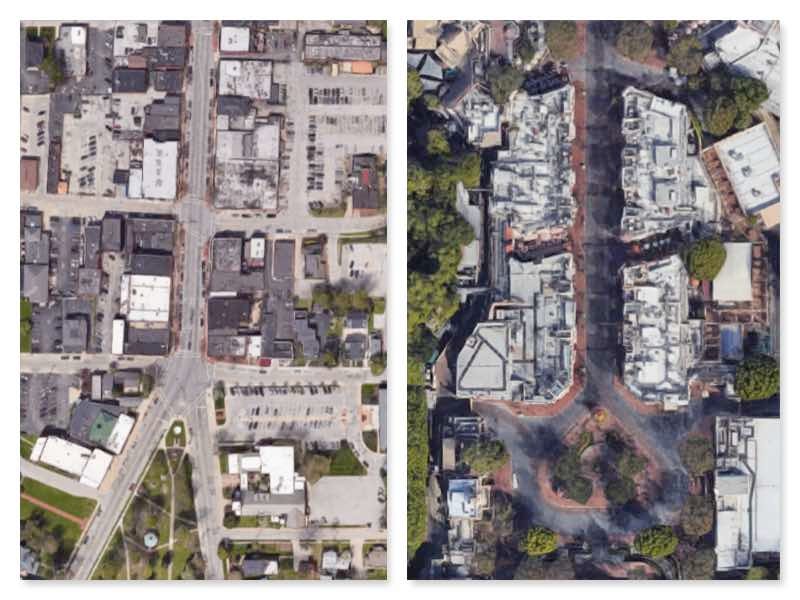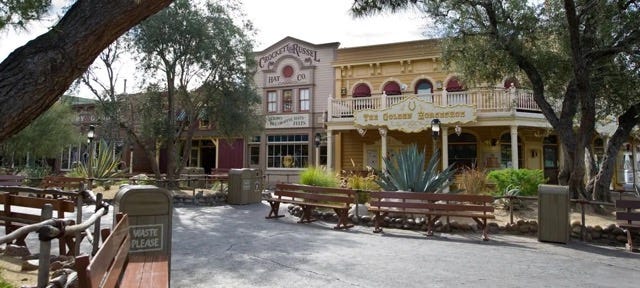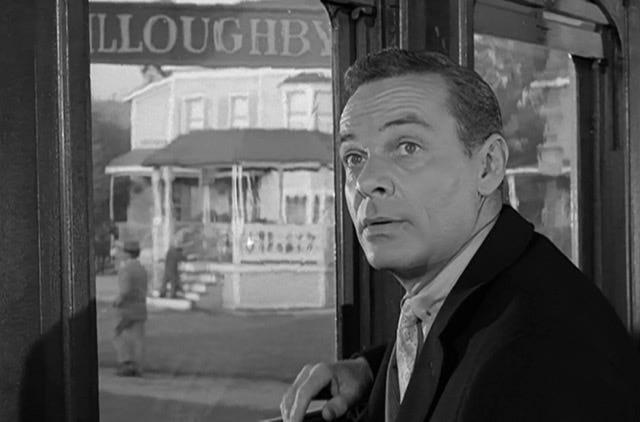My Own Main Street USA
Looking at real life Main Streets and why we now pay money to visit them in theme parks
Welcome to the Quarantine Creatives newsletter, a companion to my podcast of the same name, which explores creativity, art, and big ideas as we continue to live through this pandemic.
If you like what you’re reading, you can subscribe for free to have this newsletter delivered to your inbox on Wednesdays and Sundays:
I’ve been thinking lately about what gives our neighborhoods a sense of place. I was fortunate enough to grow up within walking distance of a “traditional” small town downtown, Willoughby, Ohio.
As a kid, my mom would take my sister and me for walks to the library to check out books. We might also stop at the local pharmacy, which sold candy bars. On weekends, I accompanied my dad on trips to the local hardware store, where the salty old men that worked there would mildly berate him for not knowing the type of screw he needed. As a child, our main street (known as Erie Street) was still a functional place where people went to transact with local businesses for necessary goods and services.
Downtown Willoughby was always evolving though. Eventually, the hardware store closed and was renovated into the “cool” local coffee shop. The pharmacy became an art gallery for a while and today is a restaurant. Many of the storefronts that once housed boutiques or little shops are now restaurants or bars, but there is still an active and vibrant street life to this little community.
Anytime that I visit Downtown Willoughby, it feels a bit like a dream world. At Christmas time, garlands hang over the street and wreaths decorate every light post. In the summer, the trees along the sidewalk leaf out and provide a cool place to stroll and browse the shop windows.
It only recently occurred to me how similar my childhood downtown is to another very famous downtown, that of Main Street USA, which greets visitors entering Disneyland in California and many of the subsequent Disney parks built around the world.
The colors may be a bit brighter and the smells a bit sweeter in a theme park, but when looking at the forms and functions of the street itself, the resemblance is uncanny.
Each block is made up of individual buildings of varying heights: some only a single story, most two stories, some three or higher (at Disneyland, it’s a single building with multiple facades, but the effect is the same). The ground level houses retail, restaurants, and professional services, while the upper levels serve as commercial office space in some instances and apartments in others.
Comparing Willoughby and Disneyland from above, the similarities become even more apparent.
Both main streets run nearly perfectly North-South. There is a town square at the bottom of both images, which sits at the delta between the converging paths that form Main Street. A flagpole is the centerpiece of both squares. In Willoughby, there is also a gazebo, which serves as an anchor of civic life. Musicians perform there in the summers and it is a backdrop to countless wedding photos. Disneyland in California does not have a gazebo, but there is one on the town square at Disneyland Paris’s Main Street. (If you’re interested in going deeper on the Disneyland Paris Main Street, listen to my podcast interview with former Disney Imagineer Eddie Sotto, who led the design of that area of the park).
In both Willoughby and Disneyland, important civic buildings surround the town square. In Willoughby, it’s City Hall, the Methodist church, a school, and the library. At Disneyland, it’s also City Hall, plus the fire station, and a theatre building called the Opera House.
Disneyland’s Main Street is meant to depict life in a turn of the century U.S. town. A horse-drawn trolley moves visitors through the theme park, replicating the streetcars and trolleys that once were prominent in many small towns. Below is a postcard from 1909 that depicts Willoughby’s electric streetcar, which used to run down the center of Erie Street and connected my little town to Downtown Cleveland.

It may seem that I’m building up to the exciting reveal that Willoughby, Ohio was the prototype for Main Street USA in California, but in fact, nothing could be further from the truth. Disneyland’s Main Street USA was supposedly inspired by the small town of Marceline, Missouri, where Walt Disney spent his childhood (though it also took design cues from Fort Collins, Colorado, where designer Harper Goff was raised). My town happens to resemble Main Street USA only because there used to be thousands of towns and cities built on this form 100 years ago.
This gets at an interesting idea that Addison Del Mastro described in his newsletter recently:
“The difference between what we call a ‘city,’ a ‘town,’ or a ‘village’ is entirely of degree, not of kind.”
Not that long ago, we transacted most of our business locally. Even in extremely rural places, there was a local post office, a local grocer, and a local hardware store where we could get most of what we needed. My great-grandfather ran one such hardware store in rural Michigan. These stores were clustered together, often near a railroad depot.
Some places served larger populations and those little settlements developed into small towns or even little cities. Even our most urban places like New York, Boston, or Chicago follow the same general format as Downtown Willoughby or Main Street USA- ground floor retail with housing above. Quoting from another interesting piece from Del Mastro:
“But take, say, Brooklyn. It’s much bigger, and much more crowded, than any small town, obviously. And culturally it’s likely very different. But take a typical Brooklyn street, take a typical small-town Main Street, strip away the identifying details, and try distinguishing them.
You quite often can’t, because in many ways, they’re the same thing…
Before the era of skyscrapers and the dominance of the automobile, at least, a city was a town that grew very big, and a town was a tiny city. The difference was of degree, not kind.”
I’ve written before about encountering “urban” places in rural Vermont, which backs up Del Mastro’s point. These mixed use spaces made shopping and commercial districts feel alive in a way that suburban strip malls never will.
I’ve often contemplated Disneyland’s Main Street USA and wondered why it exists at all. It’s a land in a theme park with no rides, which seems at odds with the mission of the park. Yet, Walt Disney saw the need to create this small city as the first thing that people encounter when entering his park.
When Disneyland opened in 1955, White America had started its flee to the suburbs, lured by subsidized housing, cheap gas, and space. The Interstate Highway system wouldn’t be established for another year, but our cities were already being transformed to favor the car. I think this shift had a profound effect on Walt Disney, even if it was subconsciously.
Main Street USA was one urban form that the park showcased, but it wasn’t the only one. Frontierland was dedicated to Davy Crockett and the Old West, but take a peek at the design of the buildings in this area. Look familiar?
While most frontier settlers were living in log cabins on large tracts of land, the version of that lifestyle that Walt chose to portray in the park was life in a frontier city. This was also the version of the Old West often seen in Western films of the era. Drama is more exciting near a saloon than out on the farm I suppose.
In Walt Disney’s lifetime, there was also an area of the park dedicated to New Orleans that closely resembled the French Quarter. This was not replicated at Walt Disney World in Florida, but instead was replaced with an area that resembles a colonial town during the Revolutionary War known as Liberty Square.
In all of these cases, the park guest is visiting an urban settlement and, as Del Mastro says, whether it’s a turn of the century small town or a dusty saloon on the prairie, they all follow the same basic form.
Even Fantasyland was rethemed in the 1980s to resemble a European village with half-timbered buildings organized around a town square. This is a similar form to what we see in other areas of the park, just 500 years old instead of 100 year old. At this point, most of Disneyland is just a series of urban spaces from different continents and eras that all weave into one another.
I am fascinated by this because Disneyland charges more than $100 per day to enter. I suspect that most people visiting theme parks are primarily there for the rides, but a big part of what keeps my family returning is the ambiance. It’s a nice place to walk around and browse in a world where those nice spaces are thinning out. And yet, small towns like this were very near to where most people were living not that long ago. So how has something that was once mundane and common become a tourist attraction?
Some small towns were built on manufacturing that later moved overseas. Waltham, Massachusetts is known as “Watch City” because the Waltham Watch Company was the first to make assembly line watches. Gardner, MA was famous for manufacturing chairs. Winchendon, MA is known as “Toy Town.”
As the industries underpinning these cities failed, many of the businesses that supported the companies and workers, like grocers, clothiers, and banks also closed down.
In more rural areas, these downtown settlements died because of the mechanization of farming, which led to a change in how farms operated. Small family farms which used to require a lot of manual labor to function became replaced by large acreage of a single crop which could be tended by machine. The populations of farming communities plummeted and the services to farmers decreased just as severely.
I often quote from Wendell Berry, and I think he sums up these changes well:
“The private ownership of farmland and public concern for the health of farming are both diminishing at an alarming rate, and they are diminishing because of the big economics and big technology represented by these visions of future agriculture.
They are diminishing because as a society we have abandoned any interest in the survival of anything small. We seem to have adopted a moral rule of thumb according to which anything big is better than anything small. As a result, the agricultural establishment has simply looked away from the possibility of an economics and a technology suited to the needs and aims of the small farmer.”
He’s describing small family farms, but the same can be true of small businesses. Whether in a rural settlement with a few outpost stores, a small town like Willoughby, or a larger city like Waltham, commerce has been consolidating into strip malls and big box stores for more than half a century now, which are mostly the purview of national chains.
As we are required to use a car for every errand and have fewer options for places to walk that are not a mall of some kind, the small town becomes a novelty rather than a necessity. This may be why people are willing to pay increasingly more to visit a Disney park that is really just recreating what was once a common building form.
Perhaps someday I’ll explore what it takes to keep these small towns alive. One piece involves public investment in infrastructure. In Willoughby, this meant upgraded sidewalks and light posts, plus sponsoring various festivals and events that draw crowds downtown. But private businesses that can attract traffic are also equally important. Customers that understand the value of shopping locally are also part of the equation, but I tend to believe in the “if you build it, they will come” mentality. If a store, restaurant, or business can stand on its own merits, people will seek it out.
We recently visited nearby Hudson, MA for ice cream. It’s a smaller town of only about 20,000 people at the western edge of the Boston suburbs. Its downtown began a revitalization with a local restaurant investing in the neighborhood, which attracted diners from throughout the region. This encouraged other businesses to set up shop in the city. The result is a charming downtown with just as much character as Willoughby or Main Street USA.
We ate our ice cream on picnic tables in an alleyway that had string lights overhead. There were apartments above the stores that looked down into this alley and there was art everywhere.
Willoughby also may have been the inspiration for a classic episode of The Twilight Zone called “A Stop at Willoughby” where a New York City professional is riding the train home to southern Connecticut and dreams of a different life. He has a demanding boss and an indifferent wife and he imagines that he is being beckoned into a turn of the century town called Willoughby, with a gazebo at its centerpiece. His fantasy becomes real for him later in the episode as he attempts to join that slower pace of life.
There are cities like Willoughby of varying sizes that are just waiting to come back to life. The buildings are there and with the right combination of investment and development, these small towns can endure. Whether you’ll be the one opening a business to bring these places back or the one patronizing those shops, I hope you will find a way to bring back some “small” things to our world.
Related Reading
If you’d like to catch up on past episodes of the Quarantine Creatives podcast, they can be found on Apple Podcasts, Spotify, or wherever you listen.
Please consider sharing this with a friend that you think might enjoy it, or better yet, share it on social media so you can tell hundreds of friends!
If you’ve missed past issues of this newsletter, they are available to read here.
Stay Safe!
Heath












I’d visit Willoughby, Ohio’s Erie Street over Disneyland’s Main Street facsimile any day! However, I actually completely agree with Disney’s intention to preserve some part of American history, which it does, and for that, I can at least appreciate its existence. But, now it’s also a sad reminder most of these Main Streets don’t exist like this any more. Credit to Willoughby for keeping their downtown alive, and glad to see Hudson, MA on the same track! Now they need to do the same with nearby Rutland here in Vermont...